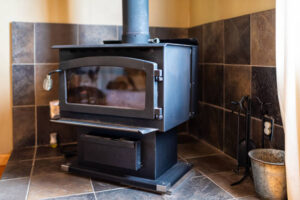Imagine this: it’s snowing outside, frost is trying to get in through the windows, and you’re holding a cup of hot chocolate. A real fire burns limestone fireplaces in the middle of the room, and the glass door shows vivid, alive flames. You remember all of a sudden why people have adored them for hundreds of years, no matter what century it is.

Let’s get to the point: wood stoves aren’t just for warming up a cold space. They are their own kind of experience. When wood pops and hisses, it sounds like something is going on. The fire is calm one minute and then wants another log the next. You can hear, feel, and smell the warmth of that dance of embers. This heat seems different to anyone who has ever cooked a marshmallow while watching logs fall.
But wood stoves teach you to be patient. Have you ever tried to stack logs in a pile that wasn’t straight? Right away, I regretted it. Building the correct fire is an art. You need to start with kindling, add some dry logs, and leave some space for air. Too much wood? It chokes. Not enough? It gets angry. You’ll have to work at it, but by next winter, lighting the stove will be second nature. Your hands could become a little dirty, but you won’t notice.
Let’s talk about gas. Not all wood is made equal. Logs that have just been cut? They’re rebels, full of smoke and water. If you burn them, you’ll get steam, smoke, and a headache. Seasoned logs that have been split and left to dry are the real MVPs. Hardwood like oak or ash is gold. Pine, on the other hand, spits and clogs your chimney. If you spy a pile of logs in someone’s yard sitting out all summer, they’re planning ahead.
Stoves aren’t simply relics for off-grid living, either. Modern designs merge old-school beauty with safety features. Glass doors enable fire-watching without the danger of flying sparks on the carpet. Adjustable air vents give you control—want a gentle burn overnight? Shut things down a bit. Throwing a party and need heat fast? Open vents wide and watch it howl.
Of course, every joyful wood stove has a grouchy side. Cleaning is part of the agreement. Ash builds up and stubbornly refuses to disappear on its own. Once a week, you’ll be scooping it out, potentially wearing an unintended mustache of soot. Don’t forget the chimney. A clean flue is a safe flue. Neglect that job, and you’ll welcome visits from irate chimney sweeps or, worse, a fire you do not want raging.
People love the independence. Power goes out? The stove stays operating as long as you have wood. There’s a hidden pride in cutting logs, piling them, and seeing your own labor warm your toes. “Sweat now, toast later,” as a buddy once put it.
But it’s not for everyone. Some demand quick warmth from a button; a stove asks you to get involved. For those who want hands-on, palpable comfort, though, the benefits come rolling in hot, smokey waves. And if you’re the kind who likes recounting stories over crackling logs, a wood stove is more than simply an appliance. It’s a companion for the cold.